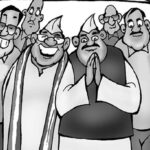Date: February 14, 2019
Location: Pulwama District, Jammu and Kashmir
Casualties: 40 CRPF personnel killed
Introduction
February 14, 2019, marked one of the darkest days in India’s fight against terrorism. The Pulwama terror attack, which led to the death of 40 Central Reserve Police Force (CRPF) personnel, shook the entire nation. The attack was not only a grave security lapse but also a brutal reminder of the persistent threat posed by cross-border terrorism in the Kashmir region.
This blog revisits the attack, its background, the immediate aftermath, and how it changed the national security landscape of India.
The Attack: What Happened?
On the afternoon of February 14, a convoy of 78 vehicles carrying over 2,500 CRPF personnel was moving from Jammu to Srinagar. As the convoy passed through the Lethpora area of Pulwama district, a suicide bomber rammed an explosive-laden SUV into one of the buses.
The impact was catastrophic — 40 CRPF jawans lost their lives on the spot, and dozens were injured. The blast was so powerful that it scattered debris across hundreds of meters and reduced the targeted bus to mangled metal.
Who Was Responsible?
The responsibility for the attack was claimed by Jaish-e-Mohammed (JeM), a Pakistan-based terrorist organization. The suicide bomber was identified as a young local recruit from Kashmir, highlighting a growing trend of radicalization within the valley.
Intelligence reports later revealed that the explosives used were military-grade RDX, raising serious concerns about how such material entered Indian territory and reached the attacker without being intercepted.
National Reaction: Grief and Outrage
The entire nation was plunged into shock and mourning. Candlelight vigils were held across the country, and citizens, from schoolchildren to senior citizens, came out to pay tribute to the fallen soldiers. There was an outpouring of solidarity, support, and anger from all corners of India.
Families of the martyrs were promised government assistance, jobs, and financial support. Indian citizens donated crores of rupees to relief funds.
But grief soon turned into outrage, with the public demanding swift and strong retaliation.
Political Response: Uniting in Crisis
The attack became a rare moment of political unity. Leaders from all major political parties came together in condemnation, setting aside their ideological differences. The government declared that it would give a “free hand to the armed forces” to respond.
The Pulwama incident also led to a significant diplomatic offensive. India launched a global campaign to isolate Pakistan diplomatically, accusing it of supporting terrorism and harboring terror groups.
Military Response: Balakot Airstrikes
Twelve days after the Pulwama attack, on February 26, 2019, the Indian Air Force conducted airstrikes across the Line of Control (LoC) in Balakot, Pakistan. It was the first time since the 1971 war that Indian jets crossed the LoC to strike deep into Pakistan-controlled territory.
The airstrikes targeted what India described as a major Jaish-e-Mohammed training camp, eliminating a significant number of militants and trainers. This marked a paradigm shift in India’s counter-terrorism strategy, signaling that future attacks would be met with direct military retaliation.
International Response
Countries around the world condemned the attack and expressed solidarity with India. Many nations supported India’s right to self-defense and urged Pakistan to dismantle terrorist infrastructure on its soil.
The Pulwama attack also triggered international debates about the use of suicide bombings, the radicalization of youth, and the need for global cooperation against terrorism.
Security Fallout: What Changed?
The Pulwama attack exposed several gaps in convoy security and intelligence coordination. In response, the government and security agencies implemented major reforms:
- Improved convoy protocols
- Use of bulletproof buses in conflict zones
- More intense background checks in local recruitment
- Enhanced surveillance along highways
Additionally, the National Investigation Agency (NIA) was tasked with a deep investigation, which eventually led to several arrests and the dismantling of local terror support cells.
Media & Public Discourse
The attack triggered an intense wave of nationalism in mainstream media and on social media platforms. While most coverage focused on honoring the martyrs and supporting national unity, some elements veered into jingoism and calls for war.
This also led to debates on responsible journalism, the role of social media in shaping public opinion, and how the nation should react to provocations without undermining democratic values.
Long-Term Impact
The Pulwama terror attack was a turning point in India’s internal and external security policy. It redefined India’s posture towards cross-border terrorism and raised public expectations for stronger counter-terrorism responses.
It also had the following long-term consequences:
- Strengthened anti-terror legislation
- Heightened focus on cyber-surveillance and intelligence
- Boost in defense spending and modernization of forces
- Tighter diplomatic stances toward nations harboring terror networks
Conclusion
The Pulwama terror attack left a scar that India will never forget. It not only highlighted the need for continuous vigilance and preparedness but also brought the nation together in a rare moment of unity and resolve.
As India moves forward, the memories of the brave CRPF personnel who laid down their lives will serve as a reminder of the cost of freedom — and the strength it takes to defend it.
“They may have killed our soldiers, but they awakened a billion hearts.”












